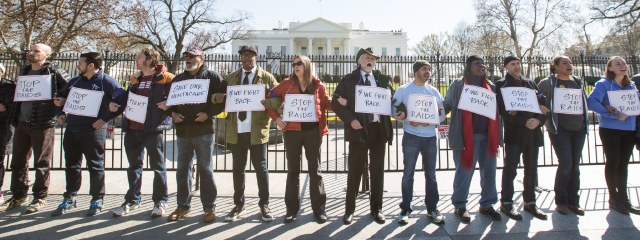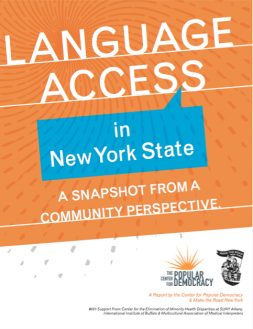Language Access - The Report
Summary
Language Access in New York State: A Snapshot from a Community Perspective
The state government provides New Yorkers with a multitude of services and benefits necessary for their survival and success: nutritional supports, health benefits, unemployment insurance and driver’s licenses, to name but a few. In order for these services to be equally accessible to all of the diverse residents of the state, it is essential that government agencies be linguistically accessible, providing interpretation and translation services for the over 2 million individuals in New York State who are limited English proficient (LEP). This report assesses the state of language access in New York, particularly access to state benefits that are critically important to low-income New Yorkers, such as public benefits, unemployment, police protection, etc. It examines the degree to which government agencies that administer state benefits programs and services are providing LEP New Yorkers with language assistance services required under a patchwork of federal, state and county-level policies.
Executive Summary
The state government provides New Yorkers with a multitude of services and benefits necessary for their survival and success: nutritional supports, health benefits, unemployment insurance and driver’s licenses, to name but a few. In order for these services to be equally accessible to all of the diverse residents of the state, it is essential that government agencies be linguistically accessible, providing interpretation and translation services for the over 2 million individuals in New York State who are limited English proficient (LEP). This report assesses the state of language access in New York, particularly access to state benefits that are critically important to low-income New Yorkers, such as public benefits, unemployment, police protection, etc. It examines the degree to which government agencies that administer state benefits programs and services are providing LEP New Yorkers with language assistance services required under a patchwork of federal, state and county-level policies.
This report is the outgrowth of years of advocacy and months of research and analysis conducted by Make the Road NY (MRNY), the Center for Popular Democracy (CPD) and three additional partner organizations across the state: the Center for the Elimination of Health Disparities (CEMHD) at SUNY Albany, Multicultural Association of Medical Interpreters (MAMI) in Central New York and the International Institute of Buffalo.
This study also grows from the experiences of the thousands of LEP New Yorkers with whom CPD, MRNY and our partners have worked in recent years. Their consistent reports concerning the barriers created by the lack of competent, consistent interpretation and translation have informed this research, and their continuing efforts to overcome and eliminate these obstacles have inspired this work. In recent years, CPD, MRNY and other members of the broader New York State Language Access Coalition have advocated for policy changes that guarantee language assistance for LEP New Yorkers in private and public settings. At the local level, the Language Access Coalition has successfully advocated for Executive Order 120 in New York City and Executive Order 10 in Suffolk County, which require local agencies to provide language assistance services to the LEP community members they serve.
In 2011, these efforts culminated with Governor Cuomo signing Executive Order 26, a statewide order which requires all state agencies with direct public contact to translate vital documents into the top six languages spoken by LEP individuals in New York State, provide interpretation services for all New Yorkers in their primary language, develop a language access plan and designate a language access coordinator.
With Executive Order 26, the Cuomo administration not only took a tremendously important step towards guaranteeing access to government services for LEP New Yorkers, it also demonstrated national leadership on this issue. New York State’s language access policy is the first of its kind. And at a time when other states across the nation were implementing regressive, anti-immigrant measures, New York demonstrated a better way forward. The administration’s commitment to language access, demonstrated by its consistent engagement with advocates in the years preceding the issuance of the Executive Order and in the months since its enactment, stands as a compelling example of how public policy can support the immigrant communities that have been powerful drivers of local economies across the state and strengthen New York as a whole.
However, the ultimate measure of the success of government and advocacy efforts is whether all LEP New Yorkers who interact with government agencies are provided with the interpretation and translation services to which they are entitled. Our findings, outlined below, suggest that this is not the case and that there is still much to be done to ensure that such New Yorkers receive competent, consistent language assistance services. In particular, during the course of our research, we have learned that many state benefits programs and services are administered by county- or locally-run entities that may not fall within the ambit of the Governor’s Executive Order 26, and may not be in jurisdictions with a county or local executive order. Access to language services and, thus, to the essential public services and benefits to which they are linked remains patchy and work must continue to be done with all levels of government—state and local—to ensure equity.













